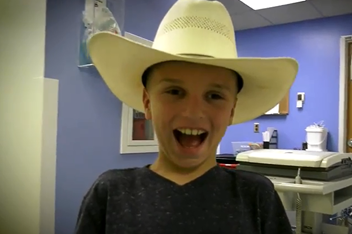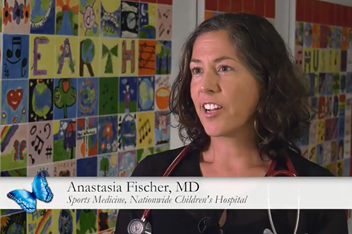Project ADAM Ohio

Project ADAM (Automated Defibrillators in Adam's Memory) aims to prevent sudden cardiac death in children and adolescents through education and implementation of life-saving programs.
Project ADAM began in 1999 after a series of sudden deaths among high school athletes in southeastern Wisconsin, including 17-year-old Adam Lemel. Many of these deaths appeared to be due to ventricular fibrillation, a condition in which the ventricles cannot pump blood into the body. Adam’s parents, Patty and Joe Lemel, collaborated with the Children’s Hospital of Wisconsin to create this program in Adam’s memory.
Project ADAM helps schools nationwide implement programs to make automated external defibrillators (AEDs) readily available by preparing schools for a cardiac emergency through emergency response plans, staff CPR and AED training, student CPR education, and sudden cardiac arrest awareness education.
An Automated External Defibrillator (AED) is a portable electronic device which, when properly applied, automatically diagnoses potentially life-threatening heart rhythms, The AED decides whether or not a shock is needed, then delivers a shock to restore normal heart rhythm.
AEDs are used to treat Sudden Cardiac Arrest (SCA). When SCA occurs, the heart suddenly and unexpectedly stops beating, cutting off blood flow to the brain and other vital organs. SCA is fatal if not treated immediately. Having access to an AED can save the life of somebody having a SCA during those critical first few minutes.
How to Use an AED: Training for Every Age
What is an AED? How do I know when to use an AED? Can I hurt someone with an AED? These are just a few of the many questions that Nationwide Children's Hospital is answering in an effort to prevent sudden cardiac death in children, adolescents and adults. While our patients used a training defibrillator to learn what to do in a cardiac emergency, every automated external defibrillator (AED) is equipped with voice prompts and instructions like the one in this video. We want you to be prepared in case of an emergency!
There are approximately 350,000 sudden cardiac deaths in the U.S. each year, equal to almost 1,000 every day. At least 600 to 1,000 of these sudden cardiac deaths occur in children or adolescents. Approximately 20 percent of a community is in its schools on any given day, including students, teachers, staff and family members. A focused effort on cardiac arrest preparedness in schools is critical to protecting our children and others in the school community.
Ohio Mandates AEDs in Schools and Sports Facilities
On July 24, 2024, Ohio Governor Mike DeWine signed House Bill 47, which now requires automated external defibrillators (AEDs) to be placed in every public and chartered nonpublic school in Ohio, as well as municipally owned or operated sports and recreation locations. Also, it requires schools to adopt emergency action plans for the use of AEDs and practice these plans quarterly.
“Sudden cardiac arrest is the number one killer of student-athletes in America,” says Governor DeWine. “We also know that the vast majority who get immediate help from an AED survive.” According to the CDC, 70-90% of cardiac arrest victims die before reaching the hospital. However, the American Heart Association reports that nine out of 10 cardiac arrest victims will live if they receive a shock from an AED in the first minute after an incident.
Nationwide Children’s is a proud affiliate of Project ADAM, which aims to prevent sudden cardiac death in children and adolescents through education and implementation of live-saving programs. This includes prepping schools for a cardiac emergency through emergency response plans, staff CPR and AED training, student CPR education, and sudden cardiac arrest education.
Schools are the setting for many community activities, including sporting events, which pose a great risk for a sudden cardiac arrest event. While the primary goal of school CPR and AED programs is to decrease the number of sudden cardiac deaths among youths, these programs have also been instrumental in saving adult lives.
Cardiac emergency response program implementation can easily be incorporated into a school's Multi-Hazard Emergency Preparedness Plan. Having CPR and AED programs in schools provides further opportunity to educate staff, students and families about sudden cardiac arrest and appropriate life saving response.
Heart Safe Schools is a heart safety program that recognizes Ohio schools for:
- Raising awareness about sudden cardiac arrest
- Implementing and sustaining life-saving cardiopulmonary resuscitation (CPR) and automated external defibrillator (AED) programs on school campus View Ohio Heart Safe School Designations
What Is the Benefit To Being a Project Adam Ohio Heart Safe School?
- Being prepared to appropriately respond to sudden cardiac arrest on campus, thereby increasing potential to save the life of a student, a staff member or visitor
- Uniting with other Ohio schools to prepare for cardiac emergencies and increase survivability of sudden cardiac arrest
- Recognition from Nationwide Children's Hospital for our life saving efforts, by way of a framed Heart Safe School certificate and listing on the Nationwide Children's Hospital website
- A letter recognizing our school for its life saving efforts, for distribution to the district superintendent, students and families
- Contribution to statewide and national research on prevention of sudden cardiac death
- Our program meets and exceeds state requirements
- With our expertise and resources, becoming heart-safe is now easier and more time-efficient than ever



